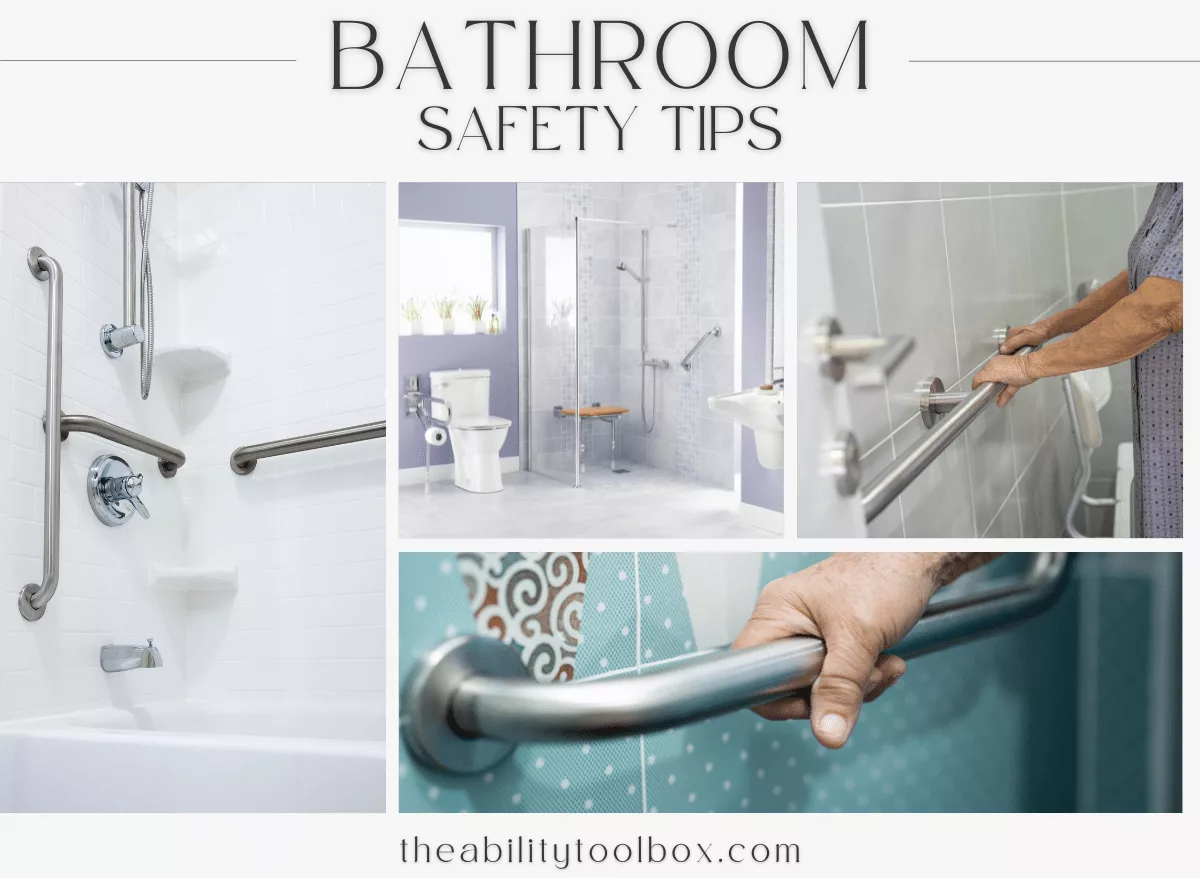The bathroom is one of the most hazardous areas in a home, especially for seniors and people with disabilities. The combination of wet surfaces, slippery floors, and limited mobility can increase the risk of accidents. These simple bathroom safety tips can prevent falls and injuries among elderly adults and other individuals with mobility challenges.
As a person with a lifelong physical disability, cerebral palsy, I have firsthand experience with bathroom safety and how to adapt a home for someone with limited mobility. I hope this advice will help you improve accessibility and reduce the danger so you or your loved one can age in place.
Bathroom Safety Facts and Statistics
One of the top safety concerns for people living independently or aging in place is fall prevention. Falls in the bathroom can have serious, even deadly outcomes. These bathroom safety statistics show how serious the issue can be:
- Falls are the leading cause of emergency room visits for seniors 65+
- 1 in 3 seniors who are injured in the bathroom will be admitted to a hospital
- Falls are the most common cause of traumatic brain injuries (TBI) and the second-leading cause of deaths
- 95% of hip fractures are due to falls, with a 50% mortality rate within six months for people aged 65 and older
- Up to 80% of falls at home occur in the bathroom
- More than 40,000 children are treated for bathroom-related injuries in hospital emergency departments each year
Whether you're able-bodied or have limited mobility, the bathroom is an especially dangerous area of your home. The combination of wet, slippery surfaces and hard surfaces creates a high risk of falling and sustaining serious head, spine, and limb injuries. Although this guide is centered on senior citizens and people with disabilities, bathroom safety affects people of all ages. Every household should implement these safety measures to protect family members from the common yet preventable injuries that occur in the bathroom.
Bathroom Safety Tips
Although bathrooms are often dangerous, they don't have to be. Here are my seven essential bathroom safety tips for seniors and people with disabilities.
1. The first step for bathroom safety is to install grab bars in the shower or bathtub area and by the toilet.
Grab bars are an essential bathroom safety feature, providing stability and support for individuals with limited balance or mobility. Install grab bars near the toilet, shower, and bathtub. These bars should be securely mounted to the wall and able to withstand the weight of the user. Remember to position them at a height that is convenient for the individual to grip and use when necessary.
Well-made grab bars do not have to look like they belong in a hospital! Invisia and Moen both make support rails that enhance the appearance of your bathroom, and some Invisia products double as bathroom essentials such as towel bars and shelves. They even come in popular finishes such as brushed nickel and oil-rubbed bronze to match your faucets and fixtures.









For more support rail recommendations, check out our Grab Bars Guide.
2. To avoid slips and falls, make sure the bathroom has non-slip surfaces.
Slips and falls are common occurrences in the bathroom, but they can be prevented by ensuring that surfaces are non-slip. Use non-slip mats or adhesive strips in the bathtub or shower to provide traction. Additionally, consider using non-slip rugs or mats on the bathroom floor to minimize the risk of slipping when stepping out of the tub or shower. It's important to regularly check and replace these non-slip surfaces as they can wear out over time.





3. Use a comfort height toilet or raised toilet seat if you have difficulty standing up from a seated position.
Lowering yourself onto a standard toilet seat and getting up from it can be challenging if you have limited mobility. I highly recommend installing a comfort height toilet, which sits higher than a standard toilet. This modification helps reduce strain on the knees and provides a higher platform on which to sit down and stand up. A higher toilet also reduces pain from sitting if you have arthritis or other joint issues.



Replacing your toilet provides the most stability and comfort for the whole family, but if that's not possible, you can use a raised toilet seat. Raised toilet seats are available in various heights and can be easily installed on top of the existing toilet bowl.




4. Use a shower chair or bathtub bench for safe bathing.
Standing for an extended period in the shower can be tiring and dangerous for older adults and individuals with limited mobility. Getting in and out of a bathtub can be extremely dangerous and may lead to serious injuries such as broken limbs. Using a shower chair or bench allows you to sit comfortably and safely while bathing. Whether you shower independently or have help from a caregiver, this simple addition can greatly enhance independence and reduce the risk of falls in the shower.


For more safe bath bench recommendations, check out our Bath and Shower Chair Guide.
5. Install a handheld showerhead so elderly people and others with disabilities can bathe while seated.
Fixed showerheads can be difficult to use if you're a senior or have limited mobility. Installing a handheld showerhead provides greater flexibility and control during bathing. With a handheld shower sprayer, you can direct the water flow to specific areas of your body while seated, making bathing and hair washing safer and more convenient. I love the shower sprayers with massage settings; they are so relaxing for sore muscles and joints!




6. Install a bidet to improve hygiene between showers with no fall risk.
If you're aging or have a physical disability, hygiene can be a challenge.



You can also buy ADA height toilets with a built-in bidet; they're more expensive, but worth it if you're replacing your toilet with a taller one for safety.



7. Make sure your bathroom is clear of obstacles and well-lit at night.
Keep the bathroom clear of any obstacles or clutter that may obstruct movement. Ensure that the pathways are wide enough for individuals using mobility aids such as walkers or wheelchairs to navigate comfortably. Avoid using rugs or mats that are not securely fastened, as they can become trip hazards. By maintaining clear pathways, individuals can move around the bathroom more easily and safely.
Proper lighting is crucial in a bathroom to prevent accidents and ensure clear visibility. Ensure that the bathroom is well-lit with bright, glare-free lights. Consider installing motion-activated lights that turn on automatically when someone enters the bathroom, eliminating the need to fumble for light switches. Nightlights and toilet bowl lights can also be useful to provide guidance during nighttime bathroom visits, reducing the risk of tripping or stumbling.



Implementing these bathroom safety tips can significantly reduce the risk of accidents and injuries for seniors and people with disabilities. Installing grab bars, using non-slip surfaces, and adding assistive devices like shower chairs can greatly enhance your independence and confidence. Adequate lighting and clear pathways are also vital to maintaining a safe bathroom environment. By making these modifications, caregivers and individuals with mobility challenges can create a bathroom that promotes safety, accessibility, and peace of mind.
Let us know what helps you in the comments below.
Founder and Editor-in-Chief of The Ability Toolbox. I received my BA in English from Stanford University and MA in Clinical Psychology from Antioch University Los Angeles, and have worked in entertainment and health media for over 20 years. I also blog about traveling with a disability. As a wheelchair user with cerebral palsy, I am deeply committed to amplifying the voices of the disability community through writing and advocacy.







